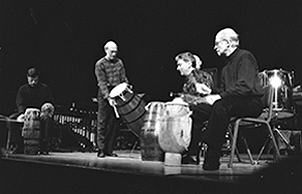






It's probably safe to say that most people at the Nexus concert at Finney Chapel last Tuesday night - however small their numbers - got a lot more than they bargained for. Nexus, world-renowned for both their remarkable percussion playing and their diverse repertoire, lived up to their reputation. In the course of the two-hour concert, their music playfully eluded any kind of musical categorization, drawing from a colorful palate of styles that ranged from traditional African dance music to 1920's ragtime.
The concert began with a piece entitled "Fauna," which was written by Nexus member Bill Cahn in 1988, after the band's first tour of Australia. "Fauna" was an attempt to paint a musical portrait of the unique and fragile wildlife that they encountered on their visit. The music was composed around a single melody and numerous variations that were heard mostly in the synthesizer and marimba.
 Electronic and acoustic instruments were combined to create a natural soundscape. Using a synthesizer, Cahn created a variety of natural sounds, like water, voices and loons. Those sounds were then combined with acoustic instruments like didgeridoo and a New Guinea war trumpet to create a wash of sounds and colors.
Electronic and acoustic instruments were combined to create a natural soundscape. Using a synthesizer, Cahn created a variety of natural sounds, like water, voices and loons. Those sounds were then combined with acoustic instruments like didgeridoo and a New Guinea war trumpet to create a wash of sounds and colors.
Although "Fauna" was interesting in parts, and some of the textures were quite enchanting, overall, it was not very exciting. Unfortunately, it brought to mind the rain forest background music that one might hear playing in The Nature Company.
The second piece on the program, "Lullaby (for Esme)" was written by Nexus member Robin Engleman in 1996 for steel pan (drum) solo. The impetus for writing the piece was a two-sided emotional response to the birth of his first grandchild and the subsequent death of Japanese composer Toru Takemitsu, with whom the group had a close relationship.
The piece's theme - taken from a Magalan lullaby - was both sentimental and haunting in its quiet simplicity. A variety of instruments - Tibetan cymbals, thundersheet, toy piano, Chinese zither, darabuka, bass harmonica, waterphone, Japanese and Tibetan prayer bowls, tuned Swiss cowbells, wooden tongue drum, shaker, toy rattle and Ghanese barrel drum - supported the melody in the steel pans.
The texture of the piece was amazingly clear, like sunlit glass, but remained warm and pliable, its rhythms and textures somehow comforting. Nexus' performance of "Lullaby" demonstrated that playing percussion isn't just about pounding on drums or supplying a well timed timpani roll in a symphony - it can be chamber music of the highest degree, as delicate and personal as a string quartet.
Whereas "Lullaby" demonstrated Nexus's capacity for quietude and introspection, the next two pieces - both adaptations of traditional African music - were high-energy, drum-based excursions into a world of rich rhythmic language and texture.
A traditional dance performed by the Ewe people of Ghana in West Africa, "Kobina" was played on the standard family of four Ewe drums, ranging from high to low pitched, an iron bell (Gankogui) and a gourd rattle (Axatse). "Mbira" was Nexus' interpretation of a traditional Zimbabwean melody. The name of the song comes from the name of the instrument itself, which is sometimes called a thumb-piano.
The mbira that Nexus used was housed inside of a large gourd, studded with bottle-tops to create a rhythmic buzz, that served as a kind of natural amplifier for the small, 22-keyed instrument. The mbira, soft and sing-songy, was accompanied by a larger metal version from the Caribbean Islands called a marimbula that provided a lower harmonic line, as well as rattle, iron bell and various drums.
The next piece, "Kichari," was the only completely improvised piece on the program. "Kichari" was based largely on this type of "call-response" playing, one sound played in reaction to another, that Cardew was so interested in. Although the sounds were created spontaneously, the intuitive communication between the men on-stage bound the whole thing together, actively drawing the audience into a freeform musical experiment.
The concert ended with a spectacular display of virtuoso xylophone music from the 1920's played by Bob Becker (who is called, reverentially, by some Conservatory percussion students "The Man with the Golden Hands.")
Xylophone music enjoyed a heyday of popularity in the 1920's and 30's - the speed and energy of new dance styles, as well as the highly technical nature of "novelty ragtime" was a perfect vehicle for the xylophone. Because of its clear, strong sound, it was often recorded and could be heard on the radio, in dance halls and even in cartoons and movies.
The ragtime music that Nexus played on Tuesday was a sampling of various styles from the time period, including a fox-trot, and the Concert Waltz in A Minor. Becker's playing was flawless - he made every note clear and distinct without losing hold of the longer melodic lines.
Nexus' music was so absorbing that most people didn't seem to mind - or even notice - the length. Nexus had an enthusiasm for their music that was contagious, and by listening to them, one felt as much a participant as an audience member.
After the concert, Bill Cahn said, "A lot of Nexus' material has grown out of things that just happened while we were improvising. I feel like tonight went really well. The magic was there. I think we all had fun."
Drumming all night: The varied performance kept the Finney crowd fascinated. (photo by Chandrika Rai)

Copyright © 1997, The Oberlin Review.
Volume 125, Number 20; April 11, 1997
Contact Review webmaster with suggestions or comments at ocreview@www.oberlin.edu.
Contact Review editorial staff at oreview@oberlin.edu.